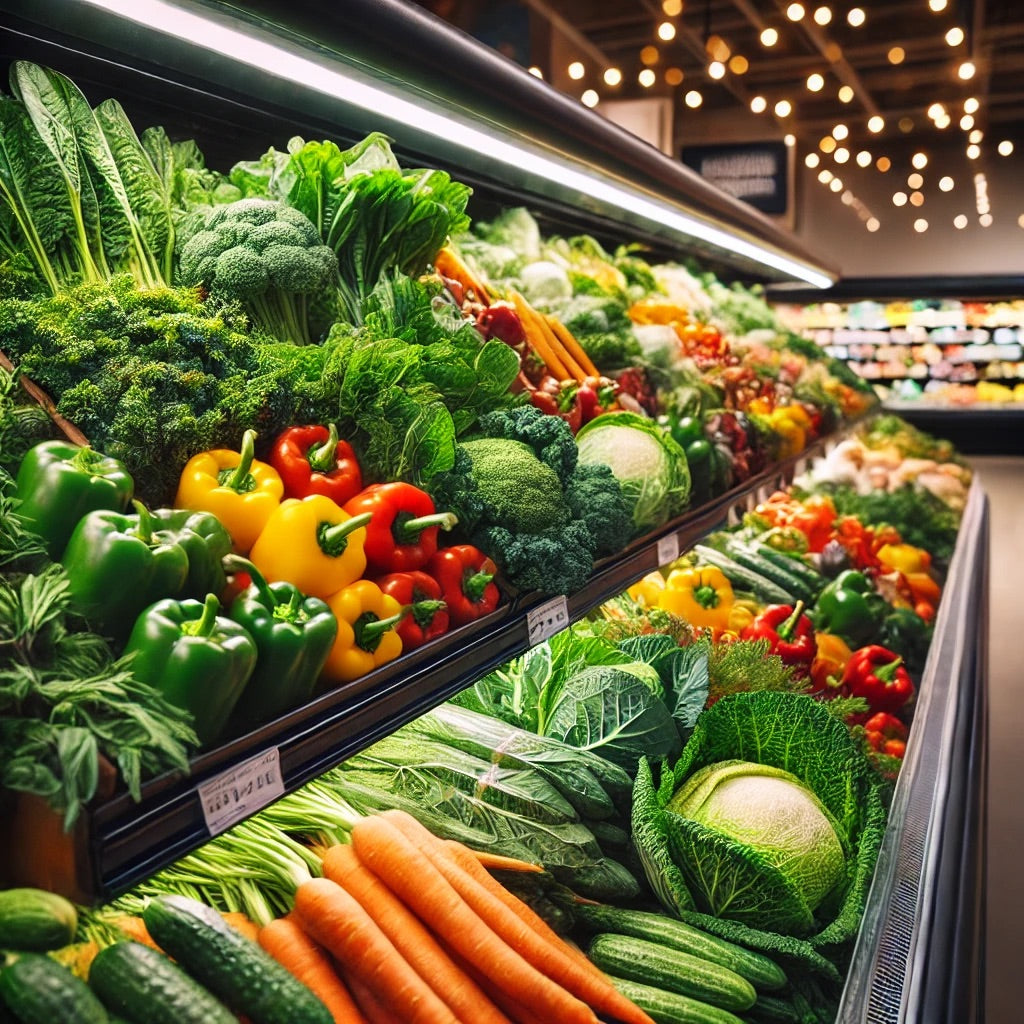
The Essential Guide to Incorporating Vegetables into Your Daily Diet
Share
Maintaining a healthy diet can be challenging. With so many items even in a grocery store that just plainly aren't healthy. However, one of the most crucial aspects of a balanced diet is the consumption of vegetables. Hint: stick to the outside parts of the grocery store, spending most of your time in the fresh veggies and fruits section. This comprehensive guide will explore why vegetables are essential, how to incorporate them into your daily meals, and provide practical tips for making vegetable consumption a habit.

The Importance of Vegetables in Your Diet
Vegetables are powerhouses of nutrition, packed with essential vitamins, minerals, fiber, and antioxidants. The general recommendation for adults is to consume at least 2.5 to 3 cups of vegetables per day, which translates to about 5-6 servings. However, this can vary based on individual health needs, lifestyle, and dietary preferences, but a good way to implement veggies in your diet.
Key Benefits of Eating Vegetables:
- Rich in Nutrients: Vegetables provide vital nutrients that our bodies need to function optimally.
- Low in Calories: Most vegetables are low in calories, making them ideal for weight management.
- High in Fiber: The fiber in vegetables aids digestion and promotes feelings of fullness.
- Disease Prevention: Regular consumption of vegetables has been linked to a reduced risk of chronic diseases.
- Hydration: Many vegetables have high water content, contributing to overall hydration.
Understanding Vegetable Categories
To ensure a diverse intake of nutrients, it's important to consume a variety of vegetables from different categories. Think eat the rainbow and no we don't mean skittles.
- Leafy Greens
- Examples: Spinach, kale, lettuce, collard greens, Swiss chard
- Benefits: High in vitamins A, C, K, and folate; rich in antioxidants
- Cruciferous Vegetables
- Examples: Broccoli, cauliflower, Brussels sprouts, cabbage
- Benefits: Contains cancer-fighting compounds and are high in fiber
- Root Vegetables
- Examples: Carrots, sweet potatoes, beets, turnips
- Benefits: Rich in complex carbohydrates and beta-carotene
- Alliums
- Examples: Onions, garlic, leeks, shallots
- Benefits: Contains sulfur compounds that may have anti-inflammatory properties
- Nightshades
- Examples: Tomatoes, peppers, eggplants
- Benefits: High in vitamins C and A; contain lycopene (especially tomatoes)
- Squash
- Examples: Zucchini, pumpkin, butternut squash
- Benefits: Rich in vitamins A and C, and contain beneficial antioxidants
- Legumes
- Examples: Peas, green beans, lentils
- Benefits: High in protein and fiber; good source of folate and iron
Seasonal Vegetables: Eating with the Rhythm of Nature
Eating seasonally not only ensures you're getting the freshest produce but also helps you diversify your vegetable intake throughout the year. Here's a guide to seasonal vegetables:
Spring
- Asparagus
- Artichokes
- Peas
- Radishes
- Spring onions
Summer
- Tomatoes
- Cucumbers
- Zucchini
- Eggplant
- Bell peppers
- Corn
Fall
- Pumpkins
- Squash (butternut, acorn)
- Brussels sprouts
- Cauliflower
- Leeks
Winter
- Kale
- Collard greens
- Turnips
- Parsnips
- Sweet potatoes
Eating seasonally often means getting vegetables at their peak flavor and nutritional value. It can also be more cost-effective and environmentally friendly.

Easy Ways to Increase Your Veggie Intake
Incorporating more vegetables into your diet doesn't have to be complicated. Here are some simple strategies:
1. Add Veggies to Every Meal
- Breakfast: Add spinach or kale to your morning smoothie or omelet.
- Lunch: Include a side salad or add extra vegetables to your sandwich.
- Dinner: Make half your plate vegetables with every dinner.
2. Snack on Veggies
- Keep cut vegetables like carrots, cucumbers, and bell peppers in the fridge for easy snacking.
- Pair raw veggies with hummus or a healthy dip for added flavor.
3. Experiment with Cooking Methods
- Roasting: Brings out natural sweetness in vegetables like Brussels sprouts and carrots.
- Grilling: Adds a smoky flavor to vegetables like zucchini and eggplant.
- Sautéing: Quick and easy way to cook leafy greens and other tender vegetables.
- Steaming: Preserves nutrients and is great for broccoli and green beans.
4. Hide Vegetables in Other Dishes
- Add grated zucchini or carrots to meatloaf or burger patties.
- Blend spinach into smoothies, sauces or soups.
- Use cauliflower rice as a substitute for regular rice.
5. Try Vegetable-Based Substitutes
- Use spiralized zucchini or spaghetti squash in place of pasta.
- Try cauliflower pizza crust instead of regular dough.
- Use lettuce wraps instead of tortillas.
If you notice you aren't gravitating toward veggies, while you are thinking through what you are going to cook train yourself to think, what vegetable am I having with this.
Creative Recipes to Boost Vegetable Consumption
Here are some delicious recipes to help you incorporate more vegetables into your diet:

Veggie-Packed Smoothie
Ingredients:
- 1 cup spinach
- 1 banana
- 1/2 cup frozen berries
- 1 cup almond milk
- 1 tbsp chia seeds
Blend all ingredients until smooth. This nutrient-dense smoothie is perfect for breakfast or a quick snack.
Roasted Vegetable Medley
Ingredients:
- 1 cup Brussels sprouts, halved
- 1 cup butternut squash, cubed
- 1 red onion, sliced
- 2 tbsp olive oil
- Salt and pepper to taste
- Optional: herbs like rosemary or thyme
Toss vegetables with olive oil, salt, pepper, and herbs. Roast at 400°F (200°C) for 25-30 minutes, stirring halfway through.
Cauliflower Fried "Rice"
Ingredients:
- 1 head cauliflower, riced
- 1 cup mixed vegetables (peas, carrots, corn)
- 2 eggs, beaten
- 2 tbsp soy sauce
- 1 tbsp sesame oil
- 2 cloves garlic, minced
Sauté garlic in sesame oil. Add cauliflower rice and mixed vegetables. Cook for 5-7 minutes. Push to the side and scramble eggs. Mix everything together and add soy sauce.

Meal Prep Tips for Vegetable Success
Meal prepping can make it easier to incorporate vegetables into your daily diet. Here are some tips:
- Wash and Chop in Advance: Prepare vegetables as soon as you get home from the grocery store. Store them in airtight containers in the fridge.
- Roast in Batches: Roast a large batch of mixed vegetables at the beginning of the week to use in various meals.
- Make Vegetable-Based Soups: Prepare a big pot of vegetable soup to eat throughout the week.
- Create a Salad Bar: Prepare different salad components and store them separately. This allows for quick and easy salad assembly during the week.
- Freeze for Later: If you have excess vegetables, chop and freeze them for future use in soups, stews, or smoothies.
Overcoming Common Challenges
Many people face obstacles when trying to increase their vegetable intake. Here are some common challenges and solutions:
1. Time Constraints
- Solution: Utilize pre-cut vegetables or frozen options for quick meal preparation.
- Tip: Dedicate time on weekends for meal prepping.
2. Taste Preferences
- Solution: Experiment with different cooking methods and seasonings to find what you enjoy.
- Tip: Start by incorporating vegetables you already like and gradually introduce new ones.
3. Cost Concerns
- Solution: Buy seasonal vegetables and consider frozen options, which can be more affordable.
- Tip: Join a local CSA (Community Supported Agriculture) program for fresh, local produce.
4. Lack of Variety
- Solution: Challenge yourself to try a new vegetable each week.
- Tip: Look for international recipes that use vegetables in unique ways.
5. Family Resistance
- Solution: Involve family members in meal planning and preparation.
- Tip: Start by making small changes, like adding one extra serving of vegetables to family favorites.
Incorporating Vegetables into Special Diets
Vegetables can play a crucial role in various dietary patterns:
Vegetarian/Vegan Diets
- Focus on a variety of vegetables to ensure adequate nutrient intake.
- Combine vegetables with legumes and grains for complete proteins.
- Consider fortified plant milks and supplements for nutrients like B12.
Low-Carb Diets
- Emphasize non-starchy vegetables like leafy greens, broccoli, and cauliflower.
- Use vegetables as substitutes for high-carb foods (e.g., cauliflower rice, zucchini noodles).
- Be mindful of portion sizes for starchier vegetables like carrots and peas.
Gluten-Free Diets
- Most vegetables are naturally gluten-free and safe to consume.
- Be cautious with processed vegetable products, which may contain gluten additives.
- Use vegetables as a base for gluten-free meals (e.g., stuffed peppers, eggplant lasagna).
Keto Diets
- Focus on low-carb vegetables like spinach, kale, and zucchini.
- Use vegetables as vehicles for healthy fats (e.g., avocado, olive oil).
- Be mindful of portion sizes for vegetables with higher carb content.
The Environmental Impact of Vegetable Consumption
Increasing vegetable intake not only benefits personal health but also has positive environmental implications:
- Reduced Carbon Footprint: Plant-based diets generally have a lower carbon footprint compared to diets high in animal products.
- Water Conservation: Growing vegetables typically requires less water than producing animal products.
- Land Use Efficiency: Vegetables can be grown more efficiently in terms of land use compared to raising livestock.
- Biodiversity: Diverse vegetable cultivation can support local ecosystems and promote biodiversity.
Making Vegetables a Lifestyle Choice
Incorporating a variety of vegetables into your daily routine is a simple yet powerful step toward better health. The benefits extend beyond personal well-being to environmental sustainability. By following the guidelines in this guide and exploring our related articles, you'll be well on your way to a healthier, more vibrant lifestyle.
Remember, the key to success is consistency and gradual change. Start by setting small, achievable goals for your vegetable intake and track your progress. Experiment with different vegetables, cooking methods, and recipes to find what works best for you and your family.
As you embark on this journey to increase your vegetable consumption, keep in mind that every small step counts. Whether it's adding an extra serving of vegetables to your dinner plate or trying a new vegetable-based recipe each week, these changes can accumulate to significant health benefits over time.
Frequently Asked Questions (FAQs)
Q. How can I ensure I’m getting enough vegetables in my diet?
A. To ensure you're getting enough vegetables, aim for at least 2.5 to 3 cups daily. Incorporate vegetables into every meal, experiment with different cooking methods, and keep cut vegetables on hand for snacking.
Q. What are some easy ways to include more vegetables in my meals?
A. You can add vegetables to smoothies, salads, soups, and stir-fries. Try using vegetable-based substitutes for pasta and rice, and include a variety of colors and types in your meals.
Q. Are frozen vegetables as nutritious as fresh ones?
A. Yes, frozen vegetables can be just as nutritious as fresh ones. They are often frozen shortly after harvest, preserving their nutrients. They can be a convenient and cost-effective option.
Q. What if I don’t like the taste of certain vegetables?
A.If you don’t like the taste of certain vegetables, try different cooking methods or seasonings. Roasting can enhance sweetness, while spices can add flavor. Start with vegetables you enjoy and gradually introduce new ones.
Q. How can I store vegetables to keep them fresh longer?
A.Store vegetables in airtight containers in the fridge. Keep leafy greens wrapped in a damp paper towel to maintain moisture. Some vegetables, like carrots and celery, can be stored in water to keep them crisp.
Q. Can I eat too many vegetables?
A. While vegetables are healthy, moderation is key. Eating a variety of foods ensures you get a balanced diet. If you have specific health conditions, consult a healthcare professional for personalized advice.
Q. What are some good vegetable options for a low-carb diet?
A. Good low-carb vegetable options include leafy greens (spinach, kale), cruciferous vegetables (broccoli, cauliflower), and other non-starchy vegetables (zucchini, bell peppers).
Q. How can I make vegetables more appealing to my family?
A. Involve your family in meal planning and preparation. Experiment with fun recipes, colorful presentations, and tasty dips to make vegetables more appealing.
For more tips, recipes, and health advice, visit our blog. Here's to your health and the vibrant world of vegetables!
